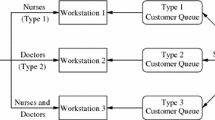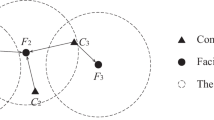Abstract
In this paper, the design and working of a patient load balancing system is described to enhance the automated patient handling in mass disasters involving scores of injured victims. The MEDTOC system developed earlier is augmented to handle the larger size of disasters resulting from mass casualty events. This load balancing system can be deployed urgently if the scope of the disaster is larger than estimated initially. It starts to operate when a large number of patients have been assigned to area hospitals and some hospitals have become overloaded. This system assigns affinity values to patients based on their trauma condition and moves the selected patients between hospitals until all the hospitals have stabilized. The system is implemented on a simulated disaster and results are presented. The results show improvement in the load conditions of hospitals.



Similar content being viewed by others
References
Zubairi, J., Misbahuddin, S., & Tasadduq, I. (2010). Emergency medical data transmission systems and techniques, Chap. 11. In Handbook of research on advances in health informatics and electronic healthcare applications: Global adoption and impact of information communication technologies. IGI publishing.
Misbahuddin, S., Olson, R., Zubairi, J., Irfan, M., & Arif, M. Client–server based transmission scheme over GSM network for MEDTOC with patient classification. In CTS 2012 IEEE Digital Library.
Gao, T., Hauenstein, L., Alm, A., & Craw, D. (2006). Vital signs monitoring and patient tracking over a wireless network. Johns Hopkins APL Technical Digest, 27(1), 66–74.
Tao, R., Poslad, S., & Bigham, J. (2013). Resilient delay sensitive load management in environment crisis messaging systems. In ICSNS 2013: The eighth international conference on systems and networks communications, Italy, 2013.
Guster, D., & Lee, O. F. (2011). Effective infrastructure protection through virtualization. In ICT and security in 21st century new development and applications. IGI publishing.
Erman-Tüysüz, A., Mutter, A., Hoesel, L. V., & Havinga, P. (2009). A cross-layered communication protocol for load balancing in large scale multi-sink wireless sensor networks. In International symposium on autonomous decentralized systems ISADS, Greece.
Gao, T., Massey, T., Selavo, L., Crawford, D., Chen, B., Lorincz, K., et al. (2007). The advanced health and disaster aid network: A light-weight wireless medical system for triag. IEEE Transactions on Biomedical Circuits and Systems, 1(3), 203–216.
Chandra-Sekaran, A.-K., Nwokafor, A., Shammas, L., Kunze, C., & Mueller-Glaser, K. D. (2009). A disaster aid sensor network using ZigBee for patient localization and air temperature monitoring. International Journal on Advances in Internet Technology, 2(1), 68–80.
Lenert, L., Kirsh, D., Griswold, W., Buono, C., Lyon, J., Rao, R., & Chan, T. (2011). Design and evaluation of a wireless electronic health records system for field care in mass casualty settings. Journal of the American Medical Informatics Association, 18(6), 842–852.
Smith, E., & Macdonald, R. (2006). Managing health information during disasters. Health Information Management Journal, 35(2), 8–13.
Moore, P. (2013). Disaster planning for healthcare facilities. People’s Medical Publishing House Ltd., China
Marres, G., Taal, L., Bemelman, M., Bouman, J., & Leenen, L. (2013). Victim tracking and tracing system (ViTTS) for major incident casualties. Prehospital and Disaster Medicine, 28(5), 445–453.
Olson, R., Zubairi, J., & Biliciler, A. (2014). A software framework for patient data handling in emergencies and disasters. In IEEE CTS Proceedings, Minneapolis.
Zubairi, J., & Idwan, S. (2015). Seed grant final report ENGR/001/15. Ras al Khaimah: American University of Ras Al Khaimah.
Acknowledgments
The authors appreciate the financial support by the American University of Ras Al Khaimah (AURAK) through seed grant funded Project No. ENGR-015-001 provided by the School of Graduate Studies and Research. Engineer Arslan Ahmed has implemented the full simulation of MEDTOC and the load balancing through C and Matlab programs and provided the results through several tables and graphs.
Author information
Authors and Affiliations
Corresponding author
Additional information
Dr. Sahar Idwan on Leave from The Hashemite University, P.O. Box 330127, Zarqa 13133, Jordan and Prof. Junaid Ahmed Zubairi on leave from State University of New York at Fredonia, Fredonia, NY USA 14063.
Rights and permissions
About this article
Cite this article
Idwan, S., Zubairi, J.A. Load Balancing for Disaster Recovery and Management. Wireless Pers Commun 90, 369–379 (2016). https://doi.org/10.1007/s11277-016-3373-y
Published:
Issue Date:
DOI: https://doi.org/10.1007/s11277-016-3373-y




